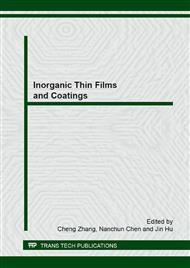[1]
N. P. Padture, M. Gell, E. H. Jordan, Thermal barrier coatings for gas-turbine engine applications, Sci. 4(2002) 280-284.
DOI: 10.1126/science.1068609
Google Scholar
[2]
Y. Shinsuke, T. Takanori, M. Takuji, Thermal and mechanical properties of SrHfO3, J. Alloy Compds. 381 (2004)295-299.
Google Scholar
[3]
G. L. Carlos, Emerging materials and processes for thermal barrier systems, Current Opinion in Solid State Mater Science. 8 (2004) 77-91.
DOI: 10.1016/j.cossms.2004.03.009
Google Scholar
[4]
L. Wang, Y. Wang, X. G. Sun, et al, A novel structure design towards extremely low thermal conductivity for thermal barrier coatings-experimental and mathematical study, Mater. Des, 35 (2012) 505-517.
DOI: 10.1016/j.matdes.2011.09.031
Google Scholar
[5]
C. Zhu, P. Li, A. Javed, et al, An investigation on the microstructure and oxidation behavior of laser remelted air plasma sprayed thermal barrier coatings, Surf. Coat. Technol. 206 (2012) 3739-3746.
DOI: 10.1016/j.surfcoat.2012.03.026
Google Scholar
[6]
G. Moskal, L. Swadzba, M. Hetmanczyk, et al, Characterization of the microstructure and thermal properties of Nd2Zr2O7 and Nd2Zr2O7/YSZ thermal barrier coatings, J. Eur. Ceram. Soc. 32 (2012) 2035-2042.
DOI: 10.1016/j.jeurceramsoc.2011.12.004
Google Scholar
[7]
G. Moskal, L. Swadzba, M. Hetmanczyk, et al, Characterization of microstructure and thermal properties of Gd2Zr2O7-type thermal barrier coating, J. Eur. Ceram. Soc. 32 (2012) 2025-2034.
DOI: 10.1016/j.jeurceramsoc.2011.11.043
Google Scholar
[8]
M. H. Habibi, L. Wang, S. M. Guo, Evolution of hot corrosion resistance of YSZ, Gd2Zr2O7, and Gd2Zr2O7+YSZ composited thermal barrier coatings in Na2SO4+V2O5 at 1050°C, J. Eur. Ceram. Soc. 32 (2012) 1635-1642
DOI: 10.1016/j.jeurceramsoc.2012.01.006
Google Scholar
[9]
L. Wang, Y. Wang, X. G. Sun, et al, Finite element simulation of residual stress of double- ceramic-layer La2Zr2O7/8YSZ thermal barrier coatings using birth and death element technique, Compt. Mater. Sci. 53 (2012) 117-127
DOI: 10.1016/j.commatsci.2011.09.028
Google Scholar
[10]
L. Wang, Y. Wang, W. Q. Zhang, et al, Finite element simulation of stress distribution and development in 8YSZ and double-ceramic-layer La2Zr2O7/8YSZ thermal barrier coatings, App. Surf. Technol. 258 (2012) 3540-3551
DOI: 10.1016/j.apsusc.2011.11.109
Google Scholar
[11]
T. Ishikawa, Thermal deformation & thermal stress of FGM plates under steadily gradient temperature fields. Proc The Frist International symp FGM, Sendai,1990,11-16.
Google Scholar
[12]
Y. Jiang, B. S. Xu, H. D. Wang, et al, Finite element modeling of residual stress around holes in the thermal barrier coatings, Compt. Mater. Sci. 49 (2010) 603-608.
DOI: 10.1016/j.commatsci.2010.05.057
Google Scholar


